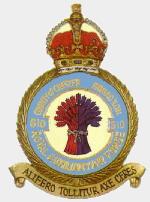Corgi AA38703 RAF Supermarine Spitfire Mk. XIV Fighter w/V-1 "Doodlebug" Flying Bomb - Richard Newbery, No.610 Squadron, RAF West Malling, England, 1944 (1:72 Scale)
"Ceres rising in a winged chariot."
- Motto of No.610 Squadron
 The Spitfire is the most famous British aircraft of all time. Although less numerous than the Hawker Hurricane, it is remembered as the sleek, thoroughbred fighting machine that turned the tide during the Battle of Britain. The Spitfire was among the fastest and most maneuverable prop-driven fighters of World War II, serving in virtually every combat theater.
The Spitfire is the most famous British aircraft of all time. Although less numerous than the Hawker Hurricane, it is remembered as the sleek, thoroughbred fighting machine that turned the tide during the Battle of Britain. The Spitfire was among the fastest and most maneuverable prop-driven fighters of World War II, serving in virtually every combat theater.
Supermarine designer Reginald Mitchell created this small, graceful, elliptical-wing fighter with eight guns in the wings that were able to fire without being hindered by the propeller. The immortal Spitfire thus became not merely one of the best-performing fighters of all time, but also one of the best-looking. Although never employed as a long-range escort, the Spitfire was a champion in an air-to-air duel. Spitfires routinely dived at the speed of sound, faster than any of the German jets.
A carrier-based version, called the Seafire, was a winner in its own right, serving valiantly on convoy routes during World War II. The Seafire 47 was even used in the early stages of the Korean War, before it was replaced by more modern jet aircraft.
Pictured here is a 1:72 scale replica of a RAF Supermarine Spitfire Mk. XIV fighter with a V-1 'Doodlebug' flying bomb. The Spitfire was piloted by Richard Newbery, who was attached to No.610 (County of Chester) Squadron, then deployed to RAF West Malling, England, during 1944.
Sold Out!
Dimensions:
Wingspan: 6-inches
Length: 4-1/2-inches
Release Date: February 2010
 Historical Account: "Chasing Buzz Bombs" - The British defense against the German long-range weapons was Operation Crossbow. Anti-aircraft guns were redeployed in several movements: first in mid-June 1944 from positions on the North Downs to the south coast of England, then a cordon closing the Thames Estuary to attacks from the east. In September 1944, a new linear defense line was formed on the coast of East Anglia, and finally in December there was a further layout along the Lincolnshire-Yorkshire coast. The deployments were prompted by changes to the approach tracks of the V-1 as launch sites were overrun by the Allies' advance.
Historical Account: "Chasing Buzz Bombs" - The British defense against the German long-range weapons was Operation Crossbow. Anti-aircraft guns were redeployed in several movements: first in mid-June 1944 from positions on the North Downs to the south coast of England, then a cordon closing the Thames Estuary to attacks from the east. In September 1944, a new linear defense line was formed on the coast of East Anglia, and finally in December there was a further layout along the Lincolnshire-Yorkshire coast. The deployments were prompted by changes to the approach tracks of the V-1 as launch sites were overrun by the Allies' advance.
On the first night of sustained bombardment, the anti-aircraft crews around Croydon were jubilant - suddenly they were downing unprecedented numbers of German bombers; most of their targets burst into flames and fell when their engines cut out. There was great disappointment when the truth was announced. Anti-aircraft gunners soon found that such small fast-moving targets were, in fact, very difficult to hit. The cruising altitude of the V-1, between 2,000 and 3,000 feet (600 to 900 m), was just above the effective range of light anti-aircraft guns, and just below the optimum engagement height of heavier guns. The altitude and speed were more than the rate of traverse of the standard British QF 3.7 inch mobile gun could cope with, and faster-traversing static gun emplacements had to be built at great cost. The development of centimetric, 3 gigahertz frequency gun-laying radars based on the cavity magnetron and of the proximity fuze helped to counter the V-1's high speed and small size. In 1944, Bell Labs started delivery of an anti-aircraft predictor fire-control system based around an analog computer, just in time for the Allied invasion of Europe.
Eventually some 2,000 barrage balloons were deployed, in the hope that V-1s would be destroyed when they struck the balloons' tethering cables. The leading edges of the V-1's wings were fitted with cable cutters, and fewer than 300 V-1s are known to have been brought down by barrage balloons. Fighters were mobilized to intercept the V-1, though most aircraft were too slow to catch a V-1 unless they had a height advantage, allowing them to gain speed by diving on the V-1 from altitude. Anti-V-1 sorties by allied aircraft were known as "Diver patrols" because of the tactic used. Hawker Tempests, Gloster Meteors and clipped-wing Spitfires were used on Diver patrols because these aircraft had sufficient speed to catch a V-1 and were also armed with 20 mm cannon. Attacking a flying bomb was highly dangerous for pilots; solid machine gun bullets had little effect on the V-1's sheet steel structure, and if an explosive cannon shell detonated the warhead, the subsequent explosion could destroy the attacking fighter. The first interception of a V-1, by F/L JG Musgrave of No. 605 Squadron RAF, took place on the night of June 14th, 1944.









